ISIS Redux: The Central Syria Insurgency in July 2021
Following is the July 2021 installment of “ISIS Redux: The Central Syria Insurgency,” a monthly chronicle of attacks by the terrorist group ISIS in central Syria. Previous editions of ISIS Redux can be viewed through the following links: June, May, April, March, February, and January 2021; and December, November, October, September, August, July, June, May, and April 2020. A full background and analysis of ISIS’s resurgence in Syria, including its methodology, can also be explored here, here and here.
ISIS militants carried out at least 21 confirmed attacks in July, killing at least 25 pro-Assad regime fighters and one civilian, while wounding at least 25 others in the Homs, Deir Ez Zor, Raqqa, and Hama governorates. The number of confirmed ISIS attacks dropped to its lowest point in a year, continuing a downward trend begun following January’s high of 47 attacks. High quality* attacks also fell in July, from a high of 15 in January to only three this month. While June’s modest rise in ISIS activity was due to an increase in attacks in Hama, July’s drop is attributable to the near total absence of ISIS attacks in that province.
As in June, ISIS continued to shift its focus away from civilians. Only two attacks in July targeted civilians, one mine and one small arms attack on shepherds. Attack lethality rose slightly compared with June, although total casualties were the lowest of the year. However, ISIS cells once again succeeded in killing a pro-regime commander.
ISIS began to increase its reliance on mines and IEDs in May, a trend which rose sharply in June and has continued into July. ISIS commonly reverts to a reliance on indirect attacks when under heavy pressure from Assad regime security forces, as has been the case for the past five months. An increasing reliance on mines and the small number of high quality attacks during the past four months suggests the organization is facing difficulties carrying out offensive actions due to sustained and widespread pressure from regime operations.
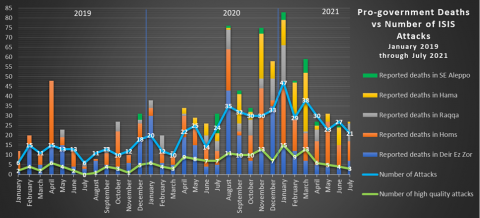
Attacks in July in Homs (10) dropped slightly for the second month in a row, while Deir Ez Zor (7) saw a significant increase in activity in the second half of the month. Meanwhile, ISIS cells conducted a quick succession of attacks in south Raqqa (3) in the first half of the month but were almost completely absent from east Hama (1) and south Aleppo (0). Unlike in past months, most of ISIS’s high quality attacks occurred in Raqqa (2) with the remaining high quality attack occurring in Homs (1).
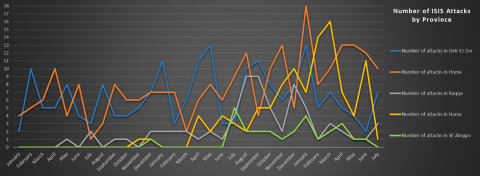
Hama
ISIS activity in east Hama had, despite some minor fluctuations, steadily risen between April 2020 and March 2021. However, in the past four months, there has been uncharacteristic inconsistency in ISIS activity in the province. Unlike June’s sharp surge in attacks, ISIS cells conducted only one attack here in July, a mine/IED hit on a pro-regime militia vehicle on the Ithriya-Sukhnah road.
It is not clear why ISIS cells have seemingly gone silent in this area. While there have been no major, sustained regime operations in east Hama in 2021, regime forces did increase their presence in the Rahjan area in July, protecting shepherds and guarding the grazing areas that ISIS had repeatedly targeted in the past months. According to one local NDF fighter, once ISIS realized it would be much more difficult to target shepherds here and steal their sheep, the local cell left, likely moving to Raqqa or Homs. However, this movement would not account for cells that had been operating elsewhere in the governorate, such as around Uqayribat and along the Ithriyah-Sukhnah highway.
With the above in mind, it seems plausible that ISIS has begun shifting resources in and out of the governorate more frequently in recent months than in the past. With its cells under increased pressure in the rest of the Badia, ISIS may be pulling fighters from east Hama to bolster operations in Homs and Raqqa, or fill in for cells in these governorates that have moved elsewhere.
Homs
ISIS activity in Homs dropped slightly for the second month in a row, but the governorate still remained the most active front in July. ISIS conducted 10 attacks in Homs, at least seven of which involved mines or IEDs. There was no geographic concentration to July’s attacks in Homs, as ISIS cells operated across the entire eastern half of the governorate.
After a quiet first week in Homs, a bus carrying 4th Division militiamen hit a mine on the Sukhnah-Resafa road, killing at least two soldiers and wounding eight. The fighters were likely on their way to or from the Kawm front. Two days later, on July 8, a mine or IED killed an IRGC soldier somewhere in the Homs Badia. That same day, a regime soldier was reported killed near Qaryatayn, close to the border of the Damascus governorate. This was the first confirmed attack near the city since March 21, 2021.
On July 11, ISIS announced that they blew up a booby-trapped building near Sukhnah as a regime patrol moved past it, wounding some of the soldiers. The next day, a regime militia commander’s vehicle was hit by an IED, killing the commander and two soldiers, near the Kawm front. On July 17, loyalist pages reported the death of a soldier somewhere in the Palmyra countryside, possibly killed by a mine during sweeping operations southeast or north of the city.
On July 25, a Syrian Arab Army (SAA) patrol hit a mine in the Wadi Qatqat area west of Sukhnah, wounding six. This came two months after a multi-IED ambush in the valley left at least 26 soldiers dead or wounded, suggesting the army is still attempting to establish a foothold and clear the area of ISIS cells and mines. Two days later, a soldier reported on his Facebook page that his vehicle had been attacked while he drove “in the Tanf area.” He later died of his wounds. The label “Tanf” often refers to any part of the Homs Badia south of the Palmyra-Humaymah Road. This is the first time the location has been referenced in an attack since February 2020, indicating that the regime may have restarted operations in this largely ignored area. Lastly, on July 29 a Syrian employed by the IRGC was wounded by a mine somewhere in the Homs Badia.
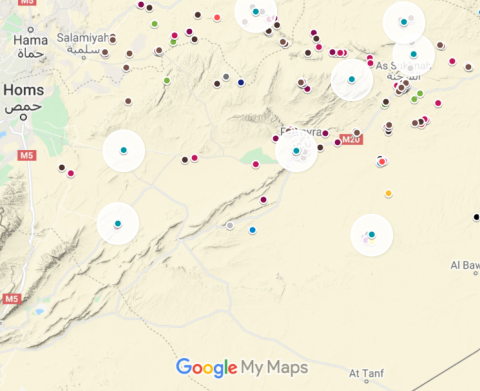
Map of ISIS attacks in Homs and Hama in July 2021 (highlighted dots). Not mapped are two additional attacks that together killed one person and wounded another somewhere in the Homs countryside.
Deir Ez Zor
The most important developments in July occurred in Deir Ez Zor. June witnessed just two attacks here, the fewest since January 2019. The first sign of activity in July came on the 10th, when a soldier was reported killed west of Mayadin. Five days later, local National Defense Forces (NDF) reported that a new group of ISIS fighters had moved into the area from Iraq and began skirmishing with regime and regime-allied forces west of Mayadin. Evidence of this renewed ISIS presence emerged over the next two weeks. From July 19 to July 28, six regime soldiers were reported killed in the Deir Ez Zor countryside, mostly by newly placed mines. All of the men killed were from western Syria, indicating that they are not part of the local NDF and were likely members of the SAA’s 4th Division, Mukhabarat, or 5th Corps.
These reports show definitively that after several months of retreat, ISIS has upped its activity in the governorate. The group’s use of fighters from Iraq to bolster its pressured cells is a timely reminder of how interconnected the Iraq and Syria insurgencies are, and the renewed emphasis in the governorate is an important development to watch in August.
Raqqa
Confirmed ISIS activity in south Raqqa in July continued to fluctuate in the one to three attacks per month range. All three attacks in southern Raqqa in July occurred in the first half of the month, yet each was significant. On July 6, ISIS fighters ambushed a patrol of Special Forces soldiers in an abandoned village south of the Ithriya-Tabqa highway. At least four soldiers were killed and six wounded in the fighting. ISIS later released pictures of the attack, including one showing the execution of one captured soldier.
On July 9, local loyalist pages reported that two trucks of ISIS fighters had attacked a group of shepherds near the village of Quway'an, south of Sabkha. This attack occurred in the same area as the June 30 attack when ISIS fighters fired on a bus transporting workers and guards to the nearby oil field. Combined, these two attacks point to a renewed ISIS presence in this area. Lastly, on July 12 a bus carrying regime soldiers hit a mine or IED in the Resafa area, killing three men and wounding five.
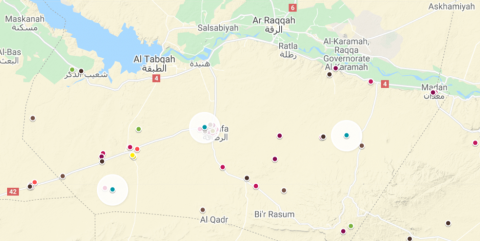
Map of ISIS attacks in Raqqa in July 2021 (highlighted dots).
Regime Operations
As in June, there were no real changes in July to the widespread anti-ISIS operations carried out by the Syrian regime and its allies that began in January 2021. Operations in the Mayadin desert and the Jabal Bishri areas of Deir Ez Zor, heavily supported and/or led by Iranians, continued. But with the renewed ISIS presence there, additional units from the Russian-backed 5th Corps were sent to this front.
The regime continues to secure the Kawm Oasis region, conducting patrols and sweeping operations in the mountains east and south of the remote Homs town. Further to the west, the SAA and Pakistani foreign fighters under the IRGC-commanded Liwa Zainebiyoun have begun extending patrols and sweeps south of Palmyra while continuing their previous operations north of the city.
In Hama, the SAA sent additional soldiers to the countryside west of Ithriyah, tasked with guarding the grazing land used by shepherds who have been repeatedly attacked by a local cell of ISIS fighters. Just north of here, the Russian-backed 25th Division extended its usual sweeps north of Ithriyah east, moving through the southern Aleppo countryside and into the Dibsi Afnan region of west Raqqa.
Looking Ahead
ISIS activity ebbed and flowed throughout July. A very quiet first week was followed by a high-tempo seven-day period between July 6 and 12 in which 10 attacks were carried out. Activity dropped off again until the last 10 days of the month, during which ISIS cells conducted seven attacks. This inconsistency and overall level of activity during a period in which regime anti-ISIS operations had not escalated in any significant manner suggests that ISIS may now be intentionally avoiding fights.
If true, this would mark a new shift in the Badia dynamic. The trajectory of the insurgency during the second half of 2020 was firmly under the control of ISIS as its cells surged unimpeded across central Syria. However, at the start of 2021 the Syrian regime and its Russian and Iranian allies attempted to assert some control over ISIS’s operation tempo. The first three months of the year saw ISIS battling hard against a concerted regime push in crucial fronts. By April, ISIS changed tact, withdrawing cells from the highly contested highways and urban frontlines and seeking refuge in the remote deserts and mountains. The regime and its allies pursued the ISIS cells here, and the militants began adopting a more defensive strategy utilizing high numbers of mines and IEDs and harassment fire from heavy weapons mounted on technicals to slow down and impede regime patrols. However, the expansion of regime operations appears to have slowed in June and nearly stopped in July. With the frontlines now more solidified, ISIS will have begun adapting to the new “status quo”, moving fighters and supplies between the Badia, northeast Syria, and Iraq as it sees fit.
The absence of attacks in eastern Hama is particularly interesting, as this further indicates that ISIS has either sent its cells into hiding for a period of time, or has begun shifting men and resources across, or out of, the Badia. If the latter is true, this could mean either an increased ISIS focus on specific parts of the Badia in August, or increased attacks in northeast Syria and/or Iraq.
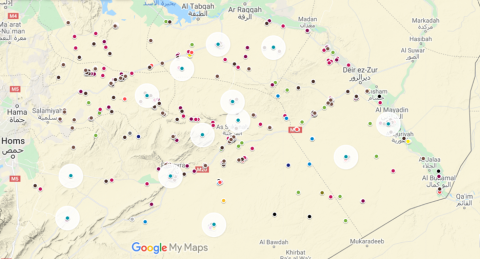
Map of locatable ISIS attacks (highlighted dots) in July 2021. This map does not include seven attacks which did not have specific locations attributed to them; two “Homs countryside” attacks, and five “Deir Ez Zor countryside” attacks. To view an interactive version of this map, please click here.
---
*High quality attacks are defined as attacks behind frontlines, those that result in seized positions, target regime officers, involve coordinated attacks on multiple positions, fake checkpoints, ambushes on military convoys, or attacks on checkpoints that kill at least three soldiers or lead to POWs.
Stay up to date on our latest news.
Get the latest news on extremism and counter-extremism delivered to your inbox.